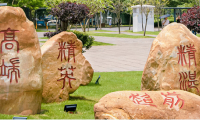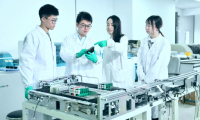
Wang, Zhigang (Assistant Professor) Assistant Professor
School of Pharmacy
Assistant Professor
BIOGRAPHICAL SKETCH
NAME: Wang, Zhigang
POSITION TITLE: Assistant Professor; School of Pharmaceutical Science, School of Medicine, Shenzhen University.
EDUCATION/TRAINING
|
INSTITUTION AND LOCATION |
DEGREE (if applicable)
|
Completion Date MM/YYYY
|
FIELD OF STUDY
|
|---|---|---|---|
|
China Agricultural University, Beijing, China |
B.Sc. |
07/2009 |
Biological Science |
|
Nankai University, Beijing, China |
M.Sc. |
06/2012 |
Bioinorganic Chemistry |
|
City University of Hong Kong, Hong Kong |
Ph.D. |
07/2017 |
Biology and Chemistry |
A. Personal Statement
My long-standing research interests are in the development of next generation antitumor drugs to circumvent the drug resistance and adverse effects of current anti-cancer drugs. Cisplatin has been used in clinic as a first line antitumor drug for almost 50 years , but it suffers from resistance and adverse effects . My lab currently focuses on two research areas to improve the therapeutic effects of cisplatin. The first area is to functionalize platinum(IV) prodrug drug s based on the DNA damage repair pathways of cisplatin. The second is to assemble nanoparticles of platinum drugs.
B. Positions and Honors
Positions and Employment
12/2017–present Assistant Professor; School of Pharmaceutical Science, School of Medicine, Shenzhen University.
C. Contributions to Science (*: corresponding/co-corresponding author)
A full list of my publications (total of 21) is enclosed at the end of this document.
1. Development of multifunctional platinum anticancer agents
Cisplatin induces the DNA damage to kill cancer cells, but the DNA damage repair pathways are able to remove the lesions induced by cisplatin. In combination, these effects result in cell survival and drug resistance. We synthesized platinum anticancer agents bearing inhibitors of DNA damage repair pathways, such as poly ADP-ribose polymerase (PARP) and nucleotide excision repair, which is able to cause DNA damage and inhibit DNA damage repair, thus leading to synergistic cell-killing effects to overcome cisplatin resistance.
2. Development of ruthenium-based anticancer agents
Ruthenium-based complexes are considered the most promising complexes to substitute platinum-based anticancer drugs, due to their low cytotoxicity and anti-metastasis properties. Our group developed multi-functional ruthenium complexes by inducing inhibitors of DNA damage repair to improve the cytotoxicity of ruthenium anticancer agents to solid tumors.
3. Drug delivery by using Mg/Al Layered double hydroxides (LDHs) nanosheets
Targeted delivery of anticancer drugs to tumors via nanomaterials as vehicles is an emerging area. Nanoparticles sized 50-200 nm tend to accumulate in tumor tissues due to enhanced permeability and retention effects (EPR). Mg/Al LDHs are readily prepared and safe to cells at a dose of 400 mg/mL. We loaded a cisplatin-based platinum(IV) prodrug into the layers of LDHs. The as-prepared nanodrug showed higher toxicity in cancer cells compared with cisplatin, but not in normal cells. We also co-loaded a platinum(IV) prodrug with p53 activators or chlorin-e6 to assemble multi-functional nanohybrids to overcome the drug resistance issue of cisplatin. Recently, we co-loaded a cisplatin prodrug and a indole-amine-2,3-dioxygenase (IDO) inhibitor into LDHs. The as-prepared nanohybrids are able to activate T cells to boost the antitumor effects of cisplatin.
Research Support
Ongoing Research Support
Shenzhen University Initiatives Fund (31530016) 01/01/2018 to 12/31/2020
Zhigang Wang, PI ¥60,000
Antitumor study of co-delivery of cisplatin prodrug and siRNA by biocompatible cationic polymer
D. Peer-reviewed publications (*: corresponding author)
1. Na Wang; Zhigang Wang; Zoufeng Xu; Xianfeng Chen; Guangyu Zhu*, 2018. A cisplatin‐Loaded Immunochemotherapeutic Nanohybrid Bearing Immune Checkpoint Inhibitors for Enhanced Cervical Cancer Therapy. Angewandte Chemie International Edition.
2. Wai‐Kin Yu; Zhigang Wang; Chi‐Chun Fong; Dandan Liu; Tak‐Chun Yip; Siu‐Kie Au; Guangyu Zhu*; Mengsu Yang*, 2017. Chemoresistant lung cancer stem cells display high DNA repair capability to remove cisplatin‐induced DNA damage. British Journal of Pharmacology, 174 (4), 302-313.
3. Li Yan; Zhigang Wang; Xianfeng Chen*; Xiao-Jun Gou; Zhenyu Zhang; Xiaoyue Zhu; Minhuan Lan; Wei Chen; Guangyu Zhu; Wenjun Zhang*, 2017. Firmly anchored photosensitizer Chlorin e6 to layered double hydroxide nanoflakes for highly efficient photodynamic therapy in vivo. Chemical Communications, 53 (15), 2339-2342.
4. Li Yan; Xianfeng Chen*; Zhigang Wang; Xiujuan Zhang; Xiaoyue Zhu; Mengjiao Zhou; Wei Chen; Longbiao Huang; Vellaisamy AL Roy; Peter KN Yu; Guangyu Zhu; Wenjun Zhang*, 2017. Size Controllable and Surface Tunable Zeolitic Imidazolate Framework-8–Poly (acrylic acid sodium salt) Nanocomposites for pH Responsive Drug Release and Enhanced in Vivo Cancer Treatment. ACS applied materials & interfaces, 9 (38), 32990-33000.
5. Wei Li; Zhen Xu; Bingzhe Xu; Chung Yuen Chan; Xudong Lin; Ying Wang; Ganchao Chen; Zhigang Wang; Qiuju Yuan; Guangyu Zhu, Hongyan Sun, Wutian Wu, Peng Shi* 2017. Investigation of the Subcellular Neurotoxicity of Amyloid‐β Using a Device Integrating Microfluidic Perfusion and Chemotactic Guidance. Advanced healthcare materials, 6 (7). 1600895
6. Zhigang Wang; Zoufeng Xu; Guangyu Zhu*, 2016. A platinum (IV) anticancer prodrug targeting nucleotide excision repair to overcome cisplatin resistance. Angewandte Chemie International Edition, 55 (50), 15564-15568.
7. Lili Ma; Rong Ma; Zhigang Wang; Shek-Man Yiu; Guangyu Zhu*, 2016. Heterodinuclear Pt (iv)–Ru (ii) anticancer prodrugs to combat both drug resistance and tumor metastasis. Chemical Communications , 52 (71), 10735-10738.
8. Fujin Ai; Tianying Sun; Zoufeng Xu; Zhigang Wang; Wei Kong; Man Wai To; Feng Wang; Guangyu Zhu*, 2016. An upconversion nanoplatform for simultaneous photodynamic therapy and Pt chemotherapy to combat cisplatin resistance. Dalton Transactions, 45 (33), 13052-13060.
9. Zoufeng Xu; Zhigang Wang; Shek-Man Yiu; Guangyu Zhu*, 2015. Mono-and di-bromo platinum (IV) prodrugs via oxidative bromination: synthesis, characterization, and cytotoxicity. Dalton Transactions, 44 (46), 19918-19926.
10. Zhigang Wang; Rong Ma; Li Yan; Xianfeng Chen; Guangyu Zhu*, 2015. Combined chemotherapy and photodynamic therapy using a nanohybrid based on layered double hydroxides to conquer cisplatin resistance. Chemical Communications, 51 (58), 11587-11590.
11. Beilei Wang; Zhigang Wang; Fujin Ai; Wai Kin Tang; Guangyu Zhu*, 2015. A monofunctional platinum (II)-based anticancer agent from a salicylanilide derivative: Synthesis, antiproliferative activity, and transcription inhibition. Journal of Inorganic Biochemistry, 142, 118-125.
12. Rong Ma; Yiping Wang; Li Yan; Lili Ma; Zhigang Wang; Hoi Ching Chan; Sung-Kay Chiu; Xianfeng Chen; Guangyu Zhu*, 2015. Efficient co-delivery of a Pt (iv) prodrug and a p53 activator to enhance the anticancer activity of cisplatin. Chemical Communications, 51 (37), 7859-7862.
13. Zhigang Wang; Hui Qian; Shek-Man Yiu; Jianwei Sun; Guangyu Zhu*, 2014. Multi-targeted organometallic ruthenium (II)–arene anticancer complexes bearing inhibitors of poly (ADP-ribose) polymerase-1: a strategy to improve cytotoxicity. Journal of Inorganic Biochemistry, 131, 47-55.
14. Ying Wang; Yang Yang; Li Yan; So Ying Kwok; Wei Li; Zhigang Wang; Xiaoyue Zhu; Guangyu Zhu; Wenjun Zhang*; Xianfeng Chen;* Peng Shi*, 2014. Poking cells for efficient vector-free intracellular delivery. Nature Communications, 5, 4466.
15. Rong Ma; Zhigang Wang; Li Yan; Xianfeng Chen; Guangyu Zhu*, 2014. Novel Pt-loaded layered double hydroxide nanoparticles for efficient and cancer-cell specific delivery of a cisplatin prodrug. Journal of Materials Chemistry B, 2 (30), 4868-4875.
16. Li Yan; Wei Chen; Xiaoyue Zhu; Longbiao Huang; Zhigang Wang; Guangyu Zhu; VAL Roy; KN Yu; Xianfeng Chen*, 2013. Folic acid conjugated self-assembled layered double hydroxide nanoparticles for high-efficacy-targeted drug delivery. Chemical Communications, 49 (93), 10938-10940.
17. Zhi-Gang Wang; Jing Lu; Chun-Yan Gao; Chao Wang; Jin-Lei Tian; Wen Gu; Xin Liu; Shi-Ping Yan, 2013. Single-ion magnet behavior of a new mononuclear dysprosium complex. Inorganic Chemistry Communications, 27, 127-130.
18. Gong-Jun Chen; Zhi-Gang Wang; Xin Qiao; Jing-Yuan Xu; Jin-Lei Tian*; Shi-Ping Yan, 2013. Synthesis, DNA binding, photo-induced DNA cleavage, cytotoxicity studies of a family of heavy rare earth complexes. Journal of Inorganic Biochemistry, 127, 39-45.
19. Gong-Jun Chen; Zhi-Gang Wang; Ying-Ying Kou; Jin-Lei Tian*; Shi-Ping Yan*, 2013. Impact of metal on the DNA photo-induced cleavage activity of a family of Phterpy complexes. Journal of Inorganic Biochemistry, 122, 49-56.
20. Gong‐Jun Chen; Zhi‐Gang Wang; Yong‐Sheng Yang; Jin‐Lei Tian; Shi‐Ping Yan*, A Nickel (II) Metallamacrocycle Complex with Antiferromagnetic Properties.2013. Zeitschrift fur Anorganische und Allgemeine Chemie , 639 (3‐4), 475-477.
21. Zhi‐Gang Wang; Ying‐Ying Kou; Jing Lu; Chun‐Yan Gao; Jin‐Lei Tian*; Shi‐Ping Yan,2012. Synthesis, magnetic properties, DNA binding and cleavage activity of a new oxalato bridged copper (II) complex. Applied Organometallic Chemistry, 26 (10), 511-517.








用户登录
还没有账号?
立即注册